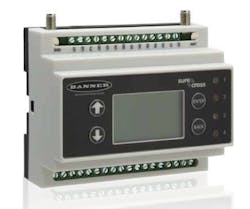In an artificial intelligence (AI) system, machine learning provides an ability to learn from experience and take action without being explicitly programmed for that particular action. Machine learning is a set of algorithms that creates its own algorithms to allow a machine to perform better.
Sensors of any kind, from temperature, flow, shock and vibration, or cameras collect the data necessary for a machine learning system to operate properly. Sensor data is sent, often wirelessly, to an edge computing device—such Banner Engineering’s DXM Wireless Gateway/Controller (Fig. 1), which uses a vibration monitoring-specific machine learning algorithm to attain key insights into machine operation and health.
1. Using machine learning algorithms, the DXM Wireless Gateway/Controller is able to gain key insights into machine operation. (Courtesy: Banner Engineering)
These wireless controllers facilitate Ethernet connectivity and industrial Internet of Things (IIoT) applications of all types. They connect local wireless networks with the internet as well as with host systems and can be programmed using action rules and text language methods. The accumulation of data over a period of time automatically allows such controllers to set a baseline of operation for the machine, and from that perspective set warning and alarm thresholds. Over time, this baseline can be adjusted and honed for greater accuracy and value.
Industries implement machine learning technology to make it easier to monitor their machines in an age of labor shortages, margin pressures, and lean inventories. Machine learning enables a company to implement predictive maintenance on their machines rather than outsourcing test and evaluation services that only periodically check for possible degridations that could lead to equipment failures. Machine learning makes it easier to implement a consistent analysis of operations.
Machine learning also makes it easy to implement predictive maintenance capabilities by remote asset monitoring, which can avoid costly unplanned downtime. Reducing unplanned downtime by just a few hours would be enough to pay for implementing a predictive maintenance system, including the sensors, edge gateway/controllers, installation, and operation.
The need to close the communications gap in the field level has been solved through the introduction of IO-Link, aimed at making validation of machines and equipment possible at that lowest level while minimizing the variety of existing interfaces such as PNP, Push-pull, 4-20mA, 0-10V, RS232, and RS422. Since IO-Link is based on conventional point-to-point wiring it requires no special cables (and can be wireless), requires no sensor addressing, and has no station limitation. In fact, nothing changes when installing or during the use of an IO-Link device. Since its inception, IO-Link has grown and expanded its abilities and reach making it more flexible in a wider variety of applications.
For example, a recent product introduction by Turck allows IO-Link (Fig. 2) devices now to be integrated into Profinet projects. Manufacturers no longer are required to manually enter properties such as device class, ranges, output signals, and manufacturer ID.
2. IO-Link is a short-distance, bidirectional, digital, industrial communications network used to connect sensors and actuators to a variety of industrial networks. (Courtesy: Turck)
Through the implementation of Turck’s IO-Link’s latest function, SIDI (Simple IO-Link Device Integration), users can integrate an IO-Link device directly into an engineering software program such as the Total Integrated Automation (TIA) Portal, which opens users to complete ranges of digitalized automation services and information.
IO-Link devices are entered as Profinet submodules in the Generic Station Description Markup Language of the IO-Link master. Turck adds all its proprietary IO-Link devices to the SIDI library—as well as devices designed and manufactured by its strategic partner for optical sensors, Banner Engineering.
Once a user connects to the SIDI GSDML network, where PLC programmers can select it from the device catalog library to use in their programming environment. Once accessed, a programmer can view and alter parameters for uses including measuring ranges, output signals, and pulse rates in a plain text field. Offline engineering also is possible when using IO-Link devices.
This works with other features to improve a machine availability allowing comprehensive status information and diagnostic capabilities to reduce downtime. The information enables predictive maintenance and asset management to be more easily implemented as part of a machine learning program.
Greater industrial connectivity, more widely deployed sensors, and more powerful analytics are all able to make improvements in efficiency and flexibility in manufacturing applications. This trend will continue well into the future, being expanded and honed for specific purposes dependent on the user’s needs.



